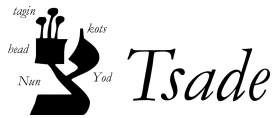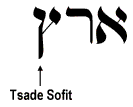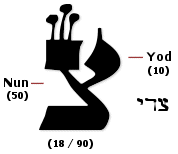|
- The Meaning of Tsade
Tzadi ( ) got its name from the shape of a "fishing hook" or perhaps a bird trap, which is related to the root tzod ( ) got its name from the shape of a "fishing hook" or perhaps a bird trap, which is related to the root tzod ( ), meaning "to hunt, catch, capture." Notice that the letter itself is formed from a bent Nun and a Vav. The Nun represents a humble and faithful servant (the crowned Vav) that is bent in submission. The Yod represents a hand lifted to heaven, or the Spirit of God. The tzaddik - the righteous person -- is therefore revealed in the letter form as a faithful servant with his arms raised before the LORD in humility. As such, some of the sages have said that the letter Tsade represents the tzaddikim (righteous ones) that are the yesod (foundation) of the earth: ), meaning "to hunt, catch, capture." Notice that the letter itself is formed from a bent Nun and a Vav. The Nun represents a humble and faithful servant (the crowned Vav) that is bent in submission. The Yod represents a hand lifted to heaven, or the Spirit of God. The tzaddik - the righteous person -- is therefore revealed in the letter form as a faithful servant with his arms raised before the LORD in humility. As such, some of the sages have said that the letter Tsade represents the tzaddikim (righteous ones) that are the yesod (foundation) of the earth: |
|
|
Since God alone is perfectly righteous and upright (tzaddik v’yashar - Deut 32:4), and His righteousness is the only true foundation of the universe, the tzaddik is said to reflect the divine image (b’tzselem elohim) when he or she lives in humility and dependence upon Him for the ability to live in trusting obedience to His will. |
|
|
- The Primordial Letter
The noted kabbalistic Rabbi Isaac Luria (1534-1572) maintained that God created the world by an act of tzimtzum ( ) -- a voluntary withdrawal or contraction -- in order to “make room” for His creation. Since tzimtzum begins with the letter Tsade, Luria reasoned that the first creative act was this voluntary humbling of God as He made room for the other forms of life He was to create. ) -- a voluntary withdrawal or contraction -- in order to “make room” for His creation. Since tzimtzum begins with the letter Tsade, Luria reasoned that the first creative act was this voluntary humbling of God as He made room for the other forms of life He was to create.

The concept of tzimtzum is somewhat paradoxical, since, on the one hand, if God did not restrict Himself, then nothing could exist - everything would be overwhelmed by God's totality; and on the other hand, God continuously sustains the created universe (immanence).
From the perspective of the tzaddik, tzimtzum means “making yourself less in order to make others more,” another allusion to the humility that is embedded within the the righteous person.
- The Mate of Aleph
Connected with the tzimtzum idea of Rabbi Luria is the view that Tsade is the “mate” of the letter Aleph. This is seen somewhat in the letter forms themselves, and suggests that God and His redeemed creation (His tzaddikim) would be joined together in love. Since Aleph represents the Creator, and Tsade represents the reflection of His image, an allusion to kallat Mashiach - the Bride of Messiah - can be seen.
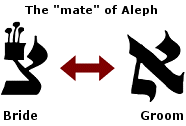
- The Gematria of Tsade
The ordinal value for Tsade is 18, with a numerical value of 90. 18 is the number of chai, life, and 90 is significant in Jewish tradition as the fulness of life, as Pirkei Avot 5:21 relates:
... At five years old a person should study the Scriptures, at ten years the Mishnah, at thirteen the commandments, at fifteen the Talmud, at eighteen the bridechamber, at twenty for one's life pursuit, at thirty for authority, at forty for discernment, at fifty for counsel, at sixty to be an elder, at seventy for gray hairs, at eighty for special strength (Psalm 90:10), at ninety for decrepitude...
Sarah was also 90 years old when she became pregnant with Yitzchak (Isaac). Moreover, the gematria for hatzaddikim (the righteous ones) and the phrase ha’or ki tov (the light was good) is the same (259). The word Tzadi ( ) itself has the value of 104, which is the same as the word le’lamed meaning “to teach.” ) itself has the value of 104, which is the same as the word le’lamed meaning “to teach.”
- The Two Forms of Tsade
The bent form of Tsade represents righteous humility, but also is a picture of the suffering Tzaddik, which is also a picture of the LORD Yeshua (as Kiddushin 406 states, “suffering atones for sins”).

The sofit form of the letter represents the elevated Tzaddik, standing up with arms lifted upward in victory and praise.
- Crowned Letters
In some Torah Scrolls, eight Hebrew letters are given special adornment by attaching three "tagin" or crownlets to them. Collectively these letters are sometimes called "sha'atnezgets" letters (for Shin, Ayin, Tet, Nun, Zayin, Gimmel, and Tsade).
Midrash ascribes the origin of the tagin as part of mattan Torah - the giving of the Torah at Sinai. The Talmud describes Moses wondering about why God was affixing these embellishments to certain letters of the Torah:
"When Moses went up to God, he found God sitting and putting little crowns on the top of the letters of the Law. He said to God, 'Who is it that forces You to put crowns to the letters of the Law [which You have already written]? He replied, 'A man is to appear on earth after many generations, Akiba b. Joseph by name, who will expound for each top of every letter of the Law heaps and heaps of rulings'...." Talmud (Menachot 29b)
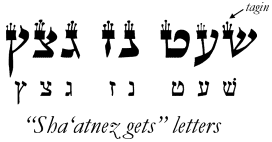
Some people have wondered if these crownlets are the "tittles" referred to by Jesus in Matthew 5:18, although it is unclear that the tagin were in use at that time. It is more likely that the "tittle" refers to the "kots" or "thorn" that projects from a letter.
|
|


